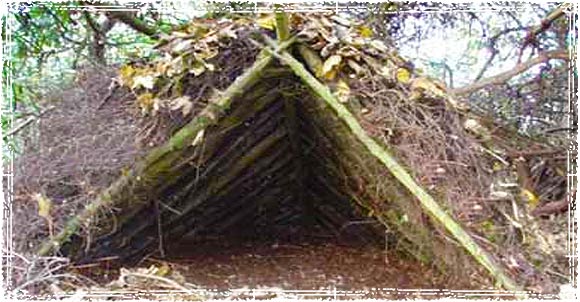You would be surprised to see all the things that you can make and do with what nature has provided. You can make weapons, tools, fire, procure food and water, and everything else you would need to do to survive with just the materials out there in the wilderness. I really like to make things for primitive survival, it is lots of fun and is challenging. I have made razor sharp knives out of rocks, string out of nettles, and bows out of saplings.
The first step to surviving in the wilderness is shelter. A person needs to be sheltered from wind, rain, snow, and extreme temperatures. There are many different kinds of shelter that you can build easily with the materials available outside, but I will only give a few examples. The key to building a good shelter is to use the natural features of the land, such as hollows, caves, ditches, and trees to make the job easier. A simple lean-to can be made from a fallen tree. The roots of a upturned tree are easy to turn into a shelter. A rock outcrop can be utilized, as well as deep snow, ice, and sand.
The first step is to find your location. It must be in a dry place that wouldn't flood when it rains, and in an area clear of insects, snakes, spiders, and other not so nice creatures. Once you know where you want it to be, you must begin making the frame. Start by adding big sticks, slowly working down to small twigs and branches until you cannot see out of the shelter. Then begin adding leaves. Lots and lots of leaves. Remember, the more leaves you have, the warmer and dryer the shelter will be. When you are done, it should look like a small, leaf covered mound with a door at the end.
| The frame of the shelter. |
 |
| Lots of leaves |
| Against a rock |
 |
| Under tree roots |
 |
| Against a tree |
The main difficulty with obtaining water is purifying it. Almost all water sources are contaminated, which means that the water has to be filtered before it is drinkable. There are several kinds of filters that you can make, but the basic idea is to run the water through a series of materials going from rough to fine. You will need to construct a filter like the one below. If you do not have any other materials, like plastic bag or such, you can use a shirt, sock, or other clothing item. If you have a pot, or piece of metal it is a good idea to boil the water for ten minutes or so to remove any bacteria, though it is unnecessary if you construct the filter correctly. If you have a good way to boil the water, you can skip the filtering part if nececcary, but the water must be brought to a rolling boil for at least ten minutes. Water provided through a solar still does not need to be purified.

Fire is a necessary element of survival. It provides warmth, protection from wild animals, and cooks food. Unfortunately, without the proper equipment a fire can be very difficult to start. However, there are several ways to start a fire without matches or a lighter, depending on the materials at hand. A water bottle or the bottom of a soda can can be used to concentrate sunlight on a certain area, eventually starting a coal. The glass/plastic part of a watch face can be used in the same way. Crossing the terminals of a powerful battery can create a spark.
If you don't have anything however, you may be able to start a fire by friction. There are several methods, the main idea is to rub two peices of wood together quickly for a long time, heating the wood slowly until you get a coal. It is very difficult, takes a long time, and requires a lot of skill and the right kind of wood. However, it can be done with perseverance.
Part Two coming next week. Maybe. More likely next year, so don't wait for it. All depends on how my life goes. Hope you learned something.

No comments:
Post a Comment